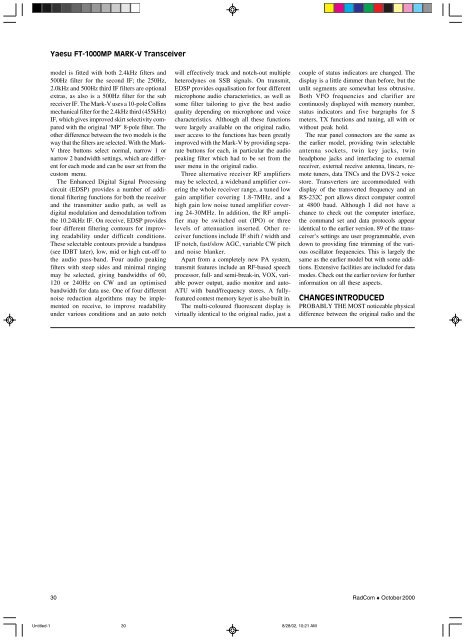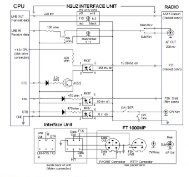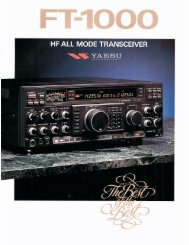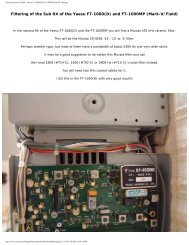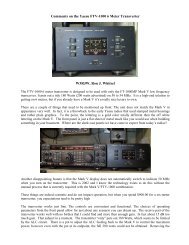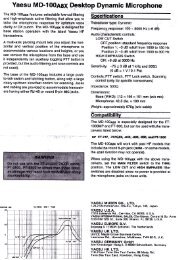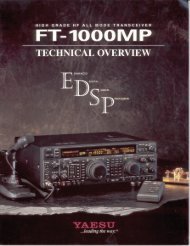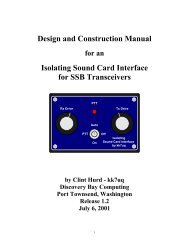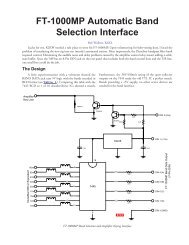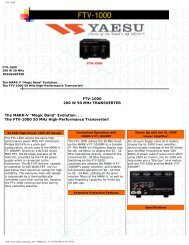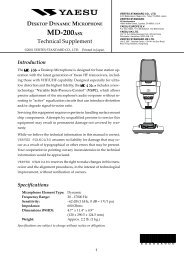Yaesu FT-1000MP MARK-V Transceivermodel is fitted with both 2.4kHz filters and500Hz filter for the second IF; the 250Hz,2.0kHz and 500Hz third IF filters are optionalextras, as also is a 500Hz filter for the subreceiver IF. The <strong>Mark</strong>-V uses a 10-pole Collinsmechanical filter for the 2.4kHz third (455kHz)IF, which gives improved skirt selectivity comparedwith the original ‘MP’ 8-pole filter. Theother difference between the two models is theway that the filters are selected. With the <strong>Mark</strong>-V three buttons select normal, narrow 1 ornarrow 2 bandwidth settings, which are differentfor each mode and can be user set from thecustom menu.The Enhanced Digital Signal Processingcircuit (EDSP) provides a number of additionalfiltering functions for both the receiverand the transmitter audio path, as well asdigital modulation and demodulation to/fromthe 10.24kHz IF. On receive, EDSP providesfour different filtering contours for improvingreadability under difficult conditions.These selectable contours provide a bandpass(see IDBT later), low, mid or high cut-off tothe audio pass-band. Four audio peakingfilters with steep sides and minimal ringingmay be selected, giving bandwidths of 60,120 or 240Hz on CW and an optimisedbandwidth for data use. One of four differentnoise reduction algorithms may be implementedon receive, to improve readabilityunder various conditions and an auto notchwill effectively track and notch-out multipleheterodynes on SSB signals. On transmit,EDSP provides equalisation for four differentmicrophone audio characteristics, as well assome filter tailoring to give the best audioquality depending on microphone and voicecharacteristics. Although all these functionswere largely available on the original radio,user access to the functions has been greatlyimproved with the <strong>Mark</strong>-V by providing separatebuttons for each, in particular the audiopeaking filter which had to be set from theuser menu in the original radio.Three alternative receiver RF amplifiersmay be selected, a wideband amplifier coveringthe whole receiver range, a tuned lowgain amplifier covering 1.8-7MHz, and ahigh gain low noise tuned amplifier covering24-30MHz. In addition, the RF amplifiermay be switched out (IPO) or threelevels of attenuation inserted. Other receiverfunctions include IF shift / width andIF notch, fast/slow AGC, variable CW pitchand noise blanker.Apart from a completely new PA system,transmit features include an RF-based speechprocessor, full- and semi-break-in, VOX, variablepower output, audio monitor and auto-ATU with band/frequency stores. A fullyfeaturedcontest memory keyer is also built in.The multi-coloured fluorescent display isvirtually identical to the original radio, just acouple of status indicators are changed. Thedisplay is a little dimmer than before, but theunlit segments are somewhat less obtrusive.Both VFO frequencies and clarifier arecontinuosly displayed with memory number,status indicators and five bargraphs for Smeters, TX functions and tuning, all with orwithout peak hold.The rear panel connectors are the same asthe earlier model, providing twin selectableantenna sockets, twin key jacks, twinheadphone jacks and interfacing to externalreceiver, external receive antenna, linears, remotetuners, data TNCs and the DVS-2 voicestore. Transverters are accommodated withdisplay of the transverted frequency and anRS-232C port allows direct computer controlat 4800 baud. Although I did not have achance to check out the computer interface,the command set and data protocols appearidentical to the earlier version. 89 of the transceiver’ssettings are user programmable, evendown to providing fine trimming of the variousoscillator frequencies. This is largely thesame as the earlier model but with some additions.Extensive facilities are included for datamodes. Check out the earlier review for furtherinformation on all these aspects.CHANGES INTRODUCEDPROBABLY THE MOST noticeable physicaldifference between the original radio and the30 RadCom ♦ October 2000Untitled-1308/28/02, 10:21 AM
Yaesu FT-1000MP MARK-V Transceiver<strong>Mark</strong>-V is the large finned heatsink that dominatesthe upper rear section of the radio. Internallythis is blown by a thermostatically controlledcross-flow fan, which engages whenthe temperature reaches 40°C. This heatsink isused to cool a new higher power PA whichconservatively delivers 200W RF output power,although the power output can be reduceddown to a level of a few watts. The PA in the<strong>Mark</strong>-V uses a push-pull pair of powerMOSFETS operating from a 30V supply rail.A unique feature of the <strong>Mark</strong>-V is the abilityto switch the PA to class A operation forgreatly improved linearity to achieve 75Woutput power with a claimed intermodulationdistortion level of -50dB. The PA transistorsdissipate 300W even when there is no RFoutput in class A, hence the need for thesubstantial heatsink. Linear amplifiers, and inparticular valve linears, generally have a lowerlevel of distortion products than the PA stagesof most transceivers. Hence even when alinear is used, benefits will normally be seen interms of a cleaner output signal if the PA in thetransceiver is operated in class A. Everyonebenefits from cleaner transmitter signals on thebands and most linears can be fully driven witharound 75W of drive.The original FT-1000MP operated from a12V supply and contained an internal powersupply for mains use. As a consequence ofadopting the new higher power PA, the<strong>Mark</strong>-V needs both 30V and 12V and isprovided with an external matching switchedmode power supply. Considering its ratedoutput, this 450W-rated supply is very light,and includes a built-in fan. Overall, the<strong>Mark</strong>-V without its power supply is 1kglighter (at 14kg) than the original radio withbuilt-in mains PSU. The size is the same(410 x 135 x 347mm).Another new feature introduced into the<strong>Mark</strong>-V is the Variable RF front-end filter(VRF), which functions on bands from 1.8to 14MHz. This provides a sharply tunedinput preselector right at the input to thereceiver, with a front panel peaking control.It uses relay switched capacitors andinductors, without any active switchingdevices. This ensures that no intermodulationproducts are generated within the filter, nomatter how strong the incoming signals (withinreason). This is ideal for eliminating secondorder intermodulation and blocking effectsfrom extremely strong broadcast stations, orwhere several transmitter stations are co-sitedin multi-multi-operator contests or DXpeditionsituations. VRF is activated by one of thebuttons on the shuttle jog tuning ring.The other button on the tuning ring activatesthe Interlocked Digital Bandwidth TrackingSystem (IDBT), another new feature with the<strong>Mark</strong>-V. The IDBT functions on SSB only andsets the bandwidth of the EDSP audio filteringto match exactly the net bandwidth of the IFfilter, also tracking the settings of the IF shiftRECEIVER MEASUREMENTSSensitivity SSB 10dBs+n:nInput for S9Frequency Flat Amp Tuned Amp Amp Out Flat Amp Tuned Amp Amp Out136 kHz - - 1.1µV - - 80µV1.8 MHz 0.2µV 0.4µV 0.5µV 28µV 50µV 80µV3.5 MHz 0.2µV 0.45µV 0.56µV 28µV 63µV 90µV7 MHz 0.22µV 0.35µV 0.45µV 32µV 56µV 80µV10 MHz 0.18µV - 0.45µV 28µV - 80µV14 MHz 0.2µV - 0.45µV 25µV - 80µV18 MHz 0.16µV - 0.45µV 20µV - 90µV24 MHz 0.2µV 0.11µV 0.56µV 28µV 7µV 110µV28 MHz 0.22µV 0.11µV 0.63µV 28µV 6µV 110µVAM sensitivity (28MHz): 0.8µV for 10dBs+n:n at 30% mod depthFM sensitivity (28MHz): 0.13µV for 12dB SINAD 3kHz pk deviationAGC threshold: 2.5µV100dB above AGC threshold for +1.5dB audio outputAGC attack time: 3ms (fast), 2ms (slow) AGC decay time: 0.2-0.3s (fast), 2s (slow)Max audio before clipping: 8ohm-1.6W, 4ohm-2.7W at 1% distortionInband intermodulation products: -26 to -40dBS-Reading Input Level SSB IF Filter IF Bandwidth(7MHz) Pre-amp Out Mode IF2/IF3 -6dB -60dBS1 7µV SSB Nor 2.4/2.4 2570Hz 3350HzS3 9µV CW Nor 2.4/2.4 2570Hz 3350HzS5 13µV CW Nar1 500/500 490Hz 940HzS7 20µV CW Nar2 250/500 355Hz 720HzS9 80µV AM / FM Thru/6k 8020Hz 13.7kHzS9+20 900µV AM Nar1 2.4/2.4 2570Hz 3350HzS9+40 10mVS9+60 110mVIntermodulation Performance (50kHz tone spacing)3rd Order Intercept Two-Tone Dynamic RangeFrequency Flat Amp Tuned Amp Amp Out Flat Amp Tuned Amp Amp Out136kHz - - +6dBm - - 81dB1.8MHz -5dBm +10dBm +22dBm 84dB 90dB 97dB3.5MHz +6dBm +16dBm +21dBm 91dB 93dB 95dB7MHz +13dBm +16dBm +18dBm 95dB 95dB 95dB14MHz +12dBm - +24dBm 95dB - 99dB21MHz +11dBm - +13dBm 95dB - 91dB28MHz +2dBm -9dBm +2dBm 88dB 85dB 82dBClose-in Dynamic Range Measurements on 7MHz Band - Pre-amp Out (IPO)Frequency 3rd Order Two Tone Blocking Reciprocal MixingOffset Intercept Dynamic Range For 3dB Noise3 kHz -9dBm 77dB -14dBm 82dB5 kHz -14dBm 73dB -14dBm 87dB7 kHz -12dBm 75dB -8dBm 91dB10 kHz -5dBm 79dB 0dBm 95dB15 kHz +10dBm 89dB >+6dBm 100dB20 kHz +18dBm 95dB >+6dBm 104dB30 kHz +18dBm 95dB >+6dBm 109dB40 kHz +18dBm 95dB >+6dBm 112dB50 kHz +18dBm 95dB >+6dBm 114dB100kHz +18dBm 95dB >+6dBm 120dB200kHz +18dBm 95dB >+6dBm 123dBSSB TWO-TONE TRANSMITTER MEASUREMENTSClass AB Class AB Class A Class ASSB (PEP) Intermod. <strong>Product</strong>s SSB (PEP) Intermod. <strong>Product</strong>sFrequency Power O/P 3rd Order 5th Order Power O/P 3rd Order 5th Order1.8MHz 220W -36 (-30)dB -42 (-36)dB 88W -41 (-35)dB -56 (-50)dB3.5MHz 195W -34 (-28)dB -42 (-36)dB 75W -40 (-34)dB -56 (-50)dB7MHz 215W -31 (-25)dB -42 (-36)dB 85W -54 (-48)dB -60 (-54)dB10MHz 212W -38 (-32)dB -44 (-38)dB 85W -56 (-50)dB -60 (-54)dB14MHz 213W -36 (-30)dB -50 (-44)dB 86W -52 (-46)dB -60 (-54)dB18MHz 211W -28 (-22)dB -54 (-48)dB 88W -52 (-46)dB -60 (-54)dB21MHz 210W -28 (-22)dB -50 (-44)dB 89W -49 (-43)dB -58 (-52)dB24MHz 212W -29 (-23)dB -44 (-38)dB 88W -52 (-46)dB -60 (-54)dB28MHz 222W -31 (-25)dB -46 (-40)dB 92W -48 (-42)dB -60 (-54)dBIntermodulation product levels are quoted with respect to PEP, figures in brackets are with respect toeither tone.Carrier suppression: >70dBSideband suppression: >80dB @ 1kHzTransmitter AF distortion:


